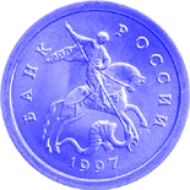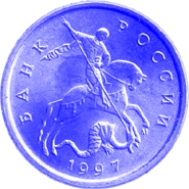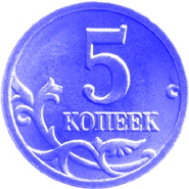by Richard Giedroyc
April 10, 2012 – It takes an act of the Russian Duma to demonetize or withdraw a coin denomination. Although the Duma is currently considering this possibility the Bank of Russia, Russia’s central bank, has already taken its own initiative, discouraging the circulation of the 1- and 5-kopek coins, the two lowest denominations now in circulation.
1-kopek. Photo: Bank of Russia.
The approach being taken by the bank is what the publication Novye Izvestia called “soft elimination.” This involves allowing the coins to circulate until they wear out. Once the coins are returned to the Russian mint for that reason they are not being replaced. If this policy continues it will take years to fully eliminate the coins, but this approach avoids any political intrigue, while hopefully avoiding encouraging inflation at the same time.
The Duma’s financial markets committee has already agreed to the proposal regarding the elimination of the 1 kopek. The proposed elimination of the 5 kopek is currently under consideration. Once the proposal is taken out of committee it would still require approval by the Duma itself.
5-kopek. Photo: Bank of Russia.
Elsewhere in the world one of the problems when the lowest coin denomination coins have been eliminated is that merchants have rounded prices up, increasing inflation through this rounding. While the March 11 issue of The Voice of Russia warned, “While this may seem as an improvement for consumers and stores that won’t have to deal with excessive coins, experts warn that this decision may be a tell-tale sign of looming inflation,” The Moscow Times newspaper countered, “The debate about the fate of the 1- and 5-kopek pieces is not new – inflation over the past decade has made the coins increasingly worthless. Many shoppers do not even bother to pick up their change when it only amounts to a few kopeks.”
The March 11 issue of Rossiiskaya Gazeta quoted Dmitry Miroshnichenko of the Higher School of Economics as saying, “This will have no impact on the economy of the country as a whole.”
The problem with these two coin denominations is twofold. Due to inflation neither denomination has much purchasing power and for that reason is seldom used in commerce. Beyond that, it costs the Russian mint more to produce the coins than is their face value due to the rising costs of stockpiling the nickel of which they are composed.
First Deputy Central Bank Chairman Georgy Luntovsky has been cautious to avoid disclosing the actual losses sustained in the manufacture of the 1- and 5-kopek coins, but he did acknowledge in the March 11 The Moscow Times the loss was “significant.”
Hard figures are available, having been published by the Bank of Russia. According to these statistics, there are approximately 7.3 billion 1-kopek and about 5.8 billion 5-kopek coins currently in circulation. It costs 47 kopeks to strike a 1-kopek coin, and 69 kopeks to strike a 5 kopek.
No statistics were immediately available regarding the other two coin denominations also in circulation, these being the 10 and 50 kopek. Each of these coins is composed of brass. Sources indicated the Russian mint continues to produce these two coins.
The elimination of all circulating Russian coins may still be in the future, not due to the rising cost of production, but due to technological advances. The Russian government is preparing a form of smart card called the Universal Electronic Card. This card would have either a microchip imbedded in it, or a magnetic strip that can be read as can the strip on a debit or credit card. The UEC system is not yet functional and in 2011 cost the government more than 100 billion rubles, according to the publication Izvestia.
Part of the holdup is over if the cards should use polyvinyl chloride (PVC) or the more durable and expensive polycarbonate known as PC. There is concern regarding the durability of such cards due to the government’s plan to have the same cards in use for at least five years before making any further changes in them. Likewise, with technology changing quickly the cards might become obsolete long before their lifespan is spent.
There are few manufacturers in Russia that can produce the PC cards, and since these cards use a magnetic strip, there is some question regarding how long the strip will remain functional.








